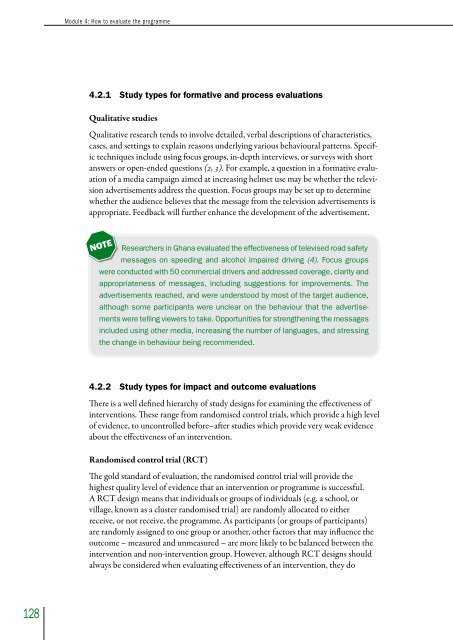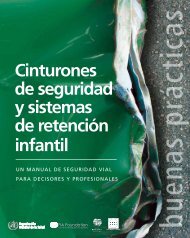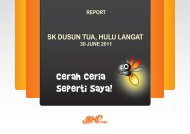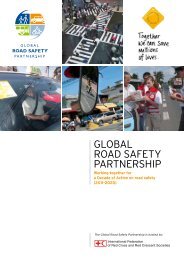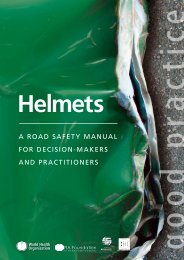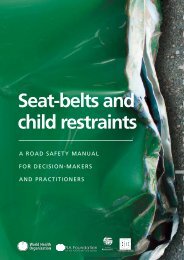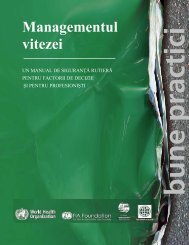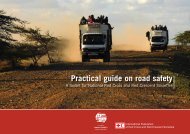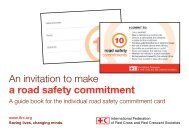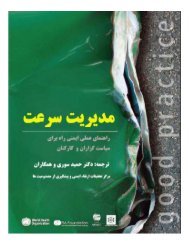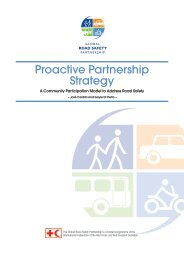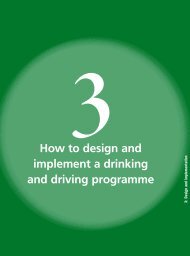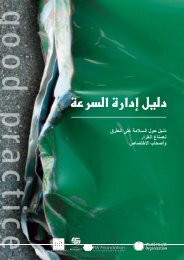How to evaluate the programme - World Health Organization
How to evaluate the programme - World Health Organization
How to evaluate the programme - World Health Organization
You also want an ePaper? Increase the reach of your titles
YUMPU automatically turns print PDFs into web optimized ePapers that Google loves.
Module 4: <strong>How</strong> <strong>to</strong> <strong>evaluate</strong> <strong>the</strong> <strong>programme</strong><br />
4.2.1 Study types for formative and process evaluations<br />
Qualitative studies<br />
Qualitative research tends <strong>to</strong> involve detailed, verbal descriptions of characteristics,<br />
cases, and settings <strong>to</strong> explain reasons underlying various behavioural patterns. Specific<br />
techniques include using focus groups, in-depth interviews, or surveys with short<br />
answers or open-ended questions (2, 3). For example, a question in a formative evaluation<br />
of a media campaign aimed at increasing helmet use may be whe<strong>the</strong>r <strong>the</strong> television<br />
advertisements address <strong>the</strong> question. Focus groups may be set up <strong>to</strong> determine<br />
whe<strong>the</strong>r <strong>the</strong> audience believes that <strong>the</strong> message from <strong>the</strong> television advertisements is<br />
appropriate. Feedback will fur<strong>the</strong>r enhance <strong>the</strong> development of <strong>the</strong> advertisement.<br />
Researchers in Ghana <strong>evaluate</strong>d <strong>the</strong> effectiveness of televised road safety<br />
messages on speeding and alcohol impaired driving (4). Focus groups<br />
were conducted with 50 commercial drivers and addressed coverage, clarity and<br />
appropriateness of messages, including suggestions for improvements. The<br />
advertisements reached, and were unders<strong>to</strong>od by most of <strong>the</strong> target audience,<br />
although some participants were unclear on <strong>the</strong> behaviour that <strong>the</strong> advertisements<br />
were telling viewers <strong>to</strong> take. Opportunities for streng<strong>the</strong>ning <strong>the</strong> messages<br />
included using o<strong>the</strong>r media, increasing <strong>the</strong> number of languages, and stressing<br />
<strong>the</strong> change in behaviour being recommended.<br />
4.2.2 Study types for impact and outcome evaluations<br />
There is a well defined hierarchy of study designs for examining <strong>the</strong> effectiveness of<br />
interventions. These range from randomised control trials, which provide a high level<br />
of evidence, <strong>to</strong> uncontrolled before–after studies which provide very weak evidence<br />
about <strong>the</strong> effectiveness of an intervention.<br />
Randomised control trial (RCT)<br />
The gold standard of evaluation, <strong>the</strong> randomised control trial will provide <strong>the</strong><br />
highest quality level of evidence that an intervention or <strong>programme</strong> is successful.<br />
A RCT design means that individuals or groups of individuals (e.g. a school, or<br />
village, known as a cluster randomised trial) are randomly allocated <strong>to</strong> ei<strong>the</strong>r<br />
receive, or not receive, <strong>the</strong> <strong>programme</strong>. As participants (or groups of participants)<br />
are randomly assigned <strong>to</strong> one group or ano<strong>the</strong>r, o<strong>the</strong>r fac<strong>to</strong>rs that may influence <strong>the</strong><br />
outcome – measured and unmeasured – are more likely <strong>to</strong> be balanced between <strong>the</strong><br />
intervention and non-intervention group. <strong>How</strong>ever, although RCT designs should<br />
always be considered when evaluating effectiveness of an intervention, <strong>the</strong>y do<br />
128


